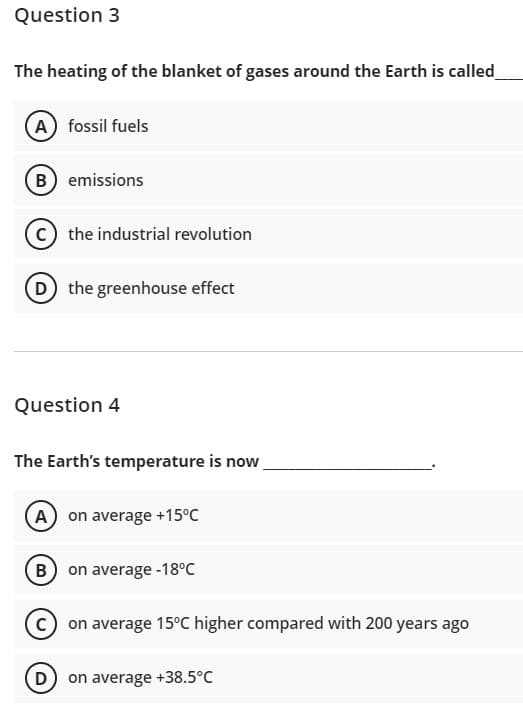Question 3 The heating of the blanket of gases around the Earth is called A fossil fuels B emissions the industrial revolution D the greenhouse effect Question 4 The Earth's temperature is now A on average +15°C B on average -18°C on average 15°C higher compared with 200 years ago on average +38.5°C
Question 3 The heating of the blanket of gases around the Earth is called A fossil fuels B emissions the industrial revolution D the greenhouse effect Question 4 The Earth's temperature is now A on average +15°C B on average -18°C on average 15°C higher compared with 200 years ago on average +38.5°C
Sustainable Energy
2nd Edition
ISBN:9781337551663
Author:DUNLAP, Richard A.
Publisher:DUNLAP, Richard A.
Chapter17: Energy Conservation
Section: Chapter Questions
Problem 3P
Related questions
Question

Transcribed Image Text:PART 1: Reading: Read the text below. Then answer the questions that follow.
(1) Around 45% of the UK's carbon dioxide emissions come from the energy people use every day - at home and when they travel.
In order to generate that energy, fossil fuels (coal, oil, and gas) are burnt, and these produce greenhouse gases - in particular
carbon dioxide (CO2). Car emissions are a major problem, but the truth is that more CO2 comes from the energy used at home. The
average household creates around five and a half tonnes of CO2 a year, and it is that same CO2 which is changing the climate and
damaging the environment.
(2) CO2 and various other gases wrap the earth in an invisible blanket helping to prevent heat from escaping. Without this
greenhouse effect, the average temperature on Earth would be around -18°C, compared with the current average of around +15°C.
The composition of this blanket of gases has remained relatively constant for many thousands of years. However, since the
industrial revolution began around 200 years ago, people have been burning increasing amounts of fossil fuels, thus releasing more
CO2 and other greenhouse gases in the process. This has increased the heating effect of the blanket, trapping more of the sun's
energy inside the Earth's atmosphere. In turn the Earth's temperature has increased more rapidly in a shorter period of time than it
has for thousands of years.
(3) In 2008, the total UK CO2 emissions were 533 million tonnes. 27% (144 million tonnes) of those emissions came from the
energy used to heat, light, and power homes. Transport emissions caused by passenger cars, buses, mopeds and motorcycles
accounted for a further 16% (87 million tonnes) of the UK's CO2 emissions. These figures show that a significant amount of CO2
results from ordinary citizens' carbon footprint in their daily activities and lifestyle.
(4) The effects of climate change can be seen all around us. Weather patterns are becoming more and more fractured and
uncertain, and over the last century trends in warm weather have become increasingly common. In the UK in the last 40 years,
winters have grown warmer, with much heavier rainfall. One of the clearest shifts over the last 200 years is towards summers that
are hotter and drier, causing pervasive water shortages. Recent years have been the hottest since records began, and during August
2003, the hottest ever outdoor temperature in the UK was recorded - 38.5°C.

Transcribed Image Text:Question 3
The heating of the blanket of gases around the Earth is called
A fossil fuels
B emissions
the industrial revolution
D the greenhouse effect
Question 4
The Earth's temperature is now
A on average +15°C
B on average -18°C
on average 15°C higher compared with 200 years ago
D) on average +38.5°C
Expert Solution
This question has been solved!
Explore an expertly crafted, step-by-step solution for a thorough understanding of key concepts.
Step by step
Solved in 2 steps with 2 images

Knowledge Booster
Learn more about
Need a deep-dive on the concept behind this application? Look no further. Learn more about this topic, civil-engineering and related others by exploring similar questions and additional content below.Recommended textbooks for you


Engineering Fundamentals: An Introduction to Engi…
Civil Engineering
ISBN:
9781305084766
Author:
Saeed Moaveni
Publisher:
Cengage Learning


Engineering Fundamentals: An Introduction to Engi…
Civil Engineering
ISBN:
9781305084766
Author:
Saeed Moaveni
Publisher:
Cengage Learning